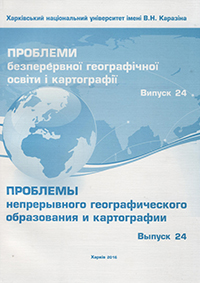Comprehensive landscape-ecological index as the basis for the areas assessment
Abstract
Currently, different methods are used for spatial assessment of environmental conditions of the territory. The most informative are geochemical methods, which involve conducting field research with the selection and analysis of samples. Typically, the analytical data are used in the calculations of environmental indexes, ratios, integral indicators, etc. The authors believe that disadvantage of these methods is ignoring the landscape features of the territory, which does not allow to objectively assess it. The article substantiates the introduction of the landscape-ecological index (LEI) to assess the environmental status of any territory. LEI calculation methodology includes a solid geochemical survey of the territory with sampling of all components of the environment (soil, vegetation, water). LEI calculation is carried out by the ratio of laboratory analysis samples results from standard rates for each sample at each point of selection and an integral factor of the landscape sensitivity in which each experimental area is located. Integral sensitivity rate of the landscape is calculated on the basis of the sensitivity assessment matrix developed by the authors. The authors foresee matrix filling based on expert assessments of the landscape sensitivity from 0 to 1, where 0 is the lowest sensitivity, and 1 - the highest. Testing methods were implemented on the example of Pechenigy reservoir basin within Kharkiv region. Based on the field experiment two indicators have been designed: a comprehensive environmental index (KEI) J.V. Gryb method, and landscape-ecological index (LEI), the author’s (N.V. Maksymenko) method. The obtained results formed the basis for mapping two models that reflect KEI and LEI spatial distribution. Comparative evaluation of the two models shows that it is the landscape-ecological index that allows a realistic assessment of the environmental condition and the environmental problems of the area.
Downloads
References
2. Klieshch, A., Maksymenko N. (2016). Geochemical analysis of the urban landscape (on the example of Кharkiv). Scientific letters of Academic Society of Michal Baludansky (Koshice, Slovakia), 4 (3), 127-130.
3. Landschafts planung / mit Beitr. von: Claus Bittner. Christina von Haaren (Hrsg.). Stuttgart: UTB, Ulmer, 2004, 527.
4. Maksy`menko, N.V. (2012). Landshaftne planuvannya yak zasib ekologichnogo vporyadkuvannya tery`toriyi [Landscape planning as means of environmental regulation of the area].The problems of continuous geographical education and cartography, 16, 65-68.
5. Maksy`menko, N.V., Klyeshh, A.A., My`xajlova, K.Yu., Gogol` O.M. (2015). Osobly`vosti landshaftno-ekologichnogo planuvannya tery`torij riznogo funkcional`nogo pry`znachennya [Features landscape and environmental planning areas of different functions]. Geografiya, ekologiya, tury`zm: teoriya, metodologiya, prakty`ka: Materialy` mizhnarod. nauk.-prakt. konferenciyi. Ternopil`: SMP «Tajp», 249-251.
6. Maksymenko, N., Cherkashina, N. (2013)/ Рrospects of landscape planning in legislation of Ukraine. Acta environmentalica universitatis comenianae (Bratislava), 21 (1), 83-88.
7. Rudenko, L.G., Golubczov, O.G. , Lisovs`ky`j, S.A., Marunyak, Ye.O., Farion, Yu.M., Chexnij, V.M. (2013). Landshaftna programa Cherkas`koyi oblasti: metody`chni pidxody` ta osnovni rezul`taty` planuvannya [Сherkassy region landscape program: methodological approaches and main results of the planning]. Ukrainian Geographical Journal, 2, 33.





